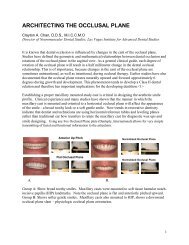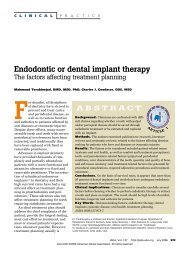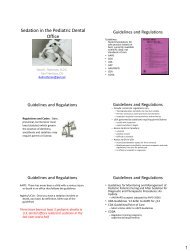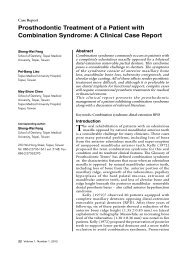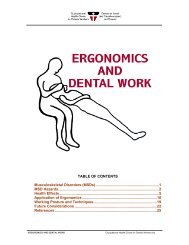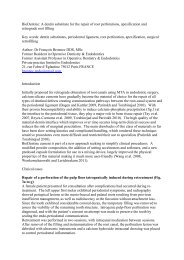Management_of_Avulsed_Permanent_Teeth
Management_of_Avulsed_Permanent_Teeth
Management_of_Avulsed_Permanent_Teeth
You also want an ePaper? Increase the reach of your titles
YUMPU automatically turns print PDFs into web optimized ePapers that Google loves.
50<br />
Traumatology<br />
Smile Magazine<br />
<strong>of</strong> the permanent teeth is the treatment <strong>of</strong><br />
choice, if it can be performed at the time<br />
and place <strong>of</strong> the accident.<br />
Furthermore, replantation should not be<br />
performed when primary teeth have been<br />
avulsed because <strong>of</strong> the risk <strong>of</strong> injury to the<br />
underlying permanent tooth germ. Treatment<br />
plan after trauma is important for a<br />
good prognosis.<br />
Dentists should always be prepared to<br />
give appropriate advice to the public<br />
about first aid for avulsed teeth. If a tooth<br />
is avulsed, make sure it is a permanent<br />
tooth:<br />
• Talk to the patient and keep him calm.<br />
• Find the tooth and pick it up by the<br />
crown and avoid touching the root.<br />
• If the tooth is dirty, wash it for about<br />
10 seconds under cold running water<br />
and reposition it. Try to encourage the<br />
patient/parent to replant the tooth. Bite<br />
on a clean piece <strong>of</strong> cloth to hold it in<br />
position.<br />
• If this is not possible, place the tooth in<br />
a suitable storage medium, e.g. a glass<br />
<strong>of</strong> milk or in saline. The tooth can also be<br />
transported in the mouth, keeping it between<br />
the molars and the inside <strong>of</strong> the<br />
cheek. These are transport media that<br />
can be used and named according to<br />
its viability respectively (milk, saline and<br />
saliva). Avoid dry storage or in water.<br />
• Seek emergency dental treatment immediately.<br />
Recommendations for the dentist:<br />
1. Medical examination for bleeding,<br />
wounds, vomiting or disorientation <strong>of</strong><br />
the patient.<br />
2. Proper dental examination.<br />
3. Radiographic examination. As a routine,<br />
several angles are recommended:<br />
a. 90° horizontal angle, with central<br />
beam through the traumatized tooth.<br />
b. occlusal view.<br />
c. lateral view from the mesial or distal<br />
aspect <strong>of</strong> the traumatized tooth.<br />
4. Sensibility tests, electric pulp test or cold<br />
test, to determine the condition <strong>of</strong> the<br />
tooth pulp. Initial tests following an injury<br />
frequently give negative results, but<br />
such results may only indicate a transient<br />
lack <strong>of</strong> pulpal response. Follow-up<br />
controls are needed to make a definitive<br />
pulpal diagnosis.<br />
5. Patient instructions. Good healing following<br />
an injury to the teeth and oral tissues<br />
depends on good oral hygiene. Patients<br />
should be advised on how to care for<br />
teeth that have received treatment<br />
after an injury. Brushing with a s<strong>of</strong>t brush<br />
and rinsing with chlorhexidine 0.1% is<br />
beneficial to prevent accumulation <strong>of</strong><br />
plaque and debris.<br />
Treatment guidelines as published in some<br />
articles (see references) by leaders in traumatic<br />
dental injuries can be followed, and<br />
I advise my colleague dentists to be a<br />
member <strong>of</strong> the International Association <strong>of</strong><br />
Dental Traumatology (IADT), to keep them<br />
up-to-date with the latest in this field.



